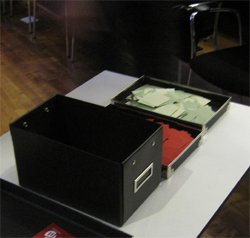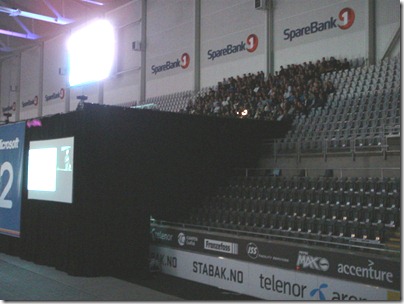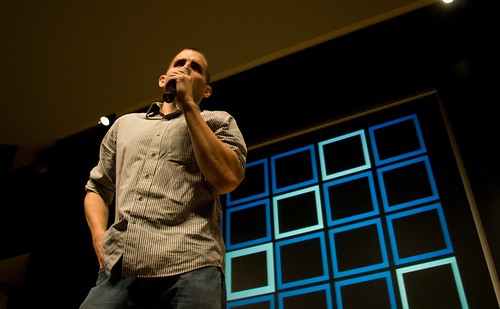Most people don’t know it, but some speakers at events they attend are paid to be there. An entire business exists for speakers, conference organizers and what are called speaker’s bureaus, for matching speakers and events together.
I interviewed Shawn Ellis, the founder of The Speakers Group, to hear an insider’s view on the speaking world.
The Speaker’s Group represents many names you know, from basketball coach Pat Riley, to Dilbert’s Scott Adams, to Man vs. Wild’s Bear Grylls. They even have a search tool to help organizers find the right speaker for their event.
SB: Do you think public speaking is important in 2009? With YouTube, twitter, etc. giving people zillions of ways to connect from anywhere at anytime, why is it people still pay money to come listen to people give presentations?
Shawn: The one thing live events have that YouTube and Twitter cannot duplicate is the energy in the room. If you’ve ever seen a comedian live and then watched that same comedian on video, you’ll notice you don’t laugh as much. It’s not as engaging. Something is missing. It’s the same material, but you’re missing the energy from everyone else in the room. The same applies to speakers. Seeing a speaker in a room full of other people is more stimulating at the least, and at best, you connect with other people at the event which can lead to further discussion and maybe even accountability to help you apply the lessons taught by the speaker.
SB: Most people I know are surprised to learn there is a public speaking economy, an entire network of organizations that help match paid speakers to venues. How would you explain what a speaker’s bureau does to someone that had never heard of such a thing before?
The term “speakers bureau†is probably foreign to anyone outside the speaking or meetings industry. Calling a speakers bureau a “booking agency for speakers†might be more easily understood. Essentially, though, I would explain our business by saying, “Meeting and event planners – from corporations, associations, non-profits or other organizations – call us when they need a speaker for their event. We learn about their needs and objectives and then help them secure the speaker who is the best match.â€
SB: In terms of payment per hour, public speaking is at the high end of wages in the world. Do people ever question you about whether speakers, or public speaking, is worth this much?
Speaker fees can be shocking to people who have not been exposed to them before. Even at the low end of the fee scale, you may be looking at a fee of $2,000, which sounds pretty good to most people. The fees of best-selling authors and celebrities, then which could be $75,000 or more, really sound outrageous! There are several things that you have to consider.
How many years did the person spend studying, researching, and making other preparations to be able to earn that appearance fee? Then how many hours did the speaker spend preparing for a presentation – researching the client organization, customizing the presentation, etc. – before that one hour on stage? And then you have to figure in travel time – it might take three days off the calendar for a single engagement. The “hourly rate†quickly starts to decline when you take this into consideration. (It’s still a good gig, of course!) But there’s something else to take into consideration: What is the value of a speaker’s presentation to an event? To an audience? To an organization?
A “celebrity†speaker may help an association draw more attendees, which increases registration revenue. A management guru may help a business’ leaders more effectively manage their teams, which could then boost corporate revenue and profits. If a company does $500 million in revenue and a speaker offers some nuggets of wisdom that spark a 1% boost in performance, that’s $5 million. How much, then, is that speaker’s time worth? So the point is, that while it’s easy to get caught up in just the dollars associated with speaker appearances, you really have to look a little closer if you want to start talking about whether or not the value is there.
It seems good public speakers are hard to find in any industry – why do you think good public speaking skills are so rare, despite how many events and conferences there are every year?
Some people just have the innate gift or talent to be a great speaker. Even someone without the gift may be able to learn the skill of public speaking. It’s a matter of aligning with some good coaches and practicing and investing the time, if you want to become a good or great public speaker. Becoming a great speaker is no different than becoming a great musician or great athlete or great actor. It takes work. It takes commitment.
What makes one speaker a better fit for a particular event than another? How do you help your clients decide which speakers will be best for which events?
Every client, every audience, every event, is unique. There are many factors to consider when selecting the “best†speaker. For instance: a speaker’s presentation style, level of content customization, availability of follow-up material (and whether or not such material is considered to be valuable), and experience or knowledge with a particular industry. Also, the time allotted for the speaker is important – because some speakers are great at 75 minutes, but will be off-balance when trying to fit into a 30-minute time slot. There is no universal “best†speaker. A speaker who is the absolute, all-time favorite of one group may fall completely flat with another group.
When we’re consulting with clients, we ask a series of questions to learn about their audience and their event objectives and their expectations to make sure we’re guiding them toward speakers who fit within their unique parameters.



 You can hack the format. The idea of a ‘slide’ is vestigial – they’re not slides anymore. I’ve hacked the format a few times, including using a special time counter deck to give me more flexibility (see photo at right). You can see this in action in
You can hack the format. The idea of a ‘slide’ is vestigial – they’re not slides anymore. I’ve hacked the format a few times, including using a special time counter deck to give me more flexibility (see photo at right). You can see this in action in